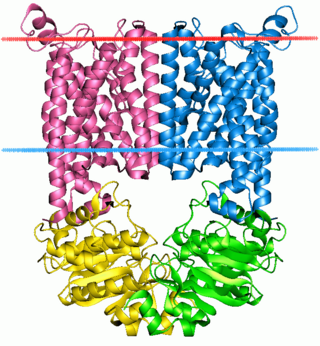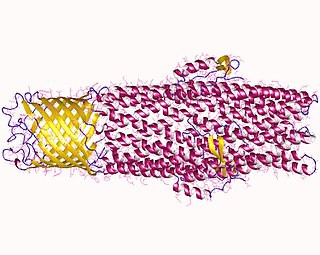
Drug resistance is the reduction in effectiveness of a medication such as an antimicrobial or an antineoplastic in treating a disease or condition. The term is used in the context of resistance that pathogens or cancers have "acquired", that is, resistance has evolved. Antimicrobial resistance and antineoplastic resistance challenge clinical care and drive research. When an organism is resistant to more than one drug, it is said to be multidrug-resistant.

The ATP-binding cassette transporters are a transport system superfamily that is one of the largest and possibly one of the oldest gene families. It is represented in all extant phyla, from prokaryotes to humans. ABC transporters belong to translocases.

P-glycoprotein 1 also known as multidrug resistance protein 1 (MDR1) or ATP-binding cassette sub-family B member 1 (ABCB1) or cluster of differentiation 243 (CD243) is an important protein of the cell membrane that pumps many foreign substances out of cells. More formally, it is an ATP-dependent efflux pump with broad substrate specificity. It exists in animals, fungi, and bacteria, and it likely evolved as a defense mechanism against harmful substances.
Multiple drug resistance (MDR), multidrug resistance or multiresistance is antimicrobial resistance shown by a species of microorganism to at least one antimicrobial drug in three or more antimicrobial categories. Antimicrobial categories are classifications of antimicrobial agents based on their mode of action and specific to target organisms. The MDR types most threatening to public health are MDR bacteria that resist multiple antibiotics; other types include MDR viruses, parasites.

Clorgiline (INN), or clorgyline (BAN), is a monoamine oxidase inhibitor (MAOI) structurally related to pargyline which is described as an antidepressant. Specifically, it is an irreversible and selective inhibitor of monoamine oxidase A (MAO-A). Clorgiline was never marketed, but it has found use in scientific research. It has been found to bind with high affinity to the σ1 receptor (Ki = 3.2 nM) and with very high affinity to the I2 imidazoline receptor (Ki = 40 pM).

In microbiology, efflux is the moving of a variety of different compounds out of cells, such as antibiotics, heavy metals, organic pollutants, plant-produced compounds, quorum sensing signals, bacterial metabolites and neurotransmitters. All microorganisms, with a few exceptions, have highly conserved DNA sequences in their genome that encode efflux pumps. Efflux pumps actively move substances out of a microorganism, in a process known as active efflux, which is a vital part of xenobiotic metabolism. This active efflux mechanism is responsible for various types of resistance to bacterial pathogens within bacterial species - the most concerning being antibiotic resistance because microorganisms can have adapted efflux pumps to divert toxins out of the cytoplasm and into extracellular media.
Calcein, also known as fluorexon, fluorescein complex, is a fluorescent dye with excitation and emission wavelengths of 495/515 nm, respectively, and has the appearance of orange crystals. Calcein self-quenches at concentrations above 70mM and is commonly used as an indicator of lipid vesicle leakage. It is also used traditionally as a complexometric indicator for titration of calcium ions with EDTA, and for fluorometric determination of calcium.

Lobeline is a pyridine alkaloid found in a variety of plants, particularly those in the genus Lobelia, including Indian tobacco, Devil's tobacco, great lobelia, Lobelia chinensis, and Hippobroma longiflora. In its pure form, it is a white amorphous powder which is freely soluble in water.

The ATP-binding cassette 4 gene encodes the Multidrug resistance protein 3. ABCB4 is associated with progressive familial intrahepatic cholestasis type 3 and intrahepatic cholestasis of pregnancy.

Multidrug resistance-associated protein 1 (MRP1) is a protein that in humans is encoded by the ABCC1 gene.
In enzymology, a xenobiotic-transporting ATPase (EC 3.6.3.44) is an enzyme that catalyzes the chemical reaction

Multidrug resistance-associated protein 2 (MRP2) also called canalicular multispecific organic anion transporter 1 (cMOAT) or ATP-binding cassette sub-family C member 2 (ABCC2) is a protein that in humans is encoded by the ABCC2 gene.

Michael M. Gottesman is an American biochemist and physician-scientist. He was the deputy director (Intramural) of the National Institutes of Health (NIH) in the United States, and also Chief of the Laboratory of Cell Biology at the National Cancer Institute (NCI) within the NIH. He graduated summa cum laude in biochemical sciences in 1966 from Harvard College, and received his M.D. magna cum laude from Harvard Medical School in 1970. He then worked as an intern and resident at the Peter Dent Brigham Hospital in Boston, a research associate at the NIH, and an assistant professor at Harvard before taking a permanent position at the NIH in 1976.
Antineoplastic resistance, often used interchangeably with chemotherapy resistance, is the resistance of neoplastic (cancerous) cells, or the ability of cancer cells to survive and grow despite anti-cancer therapies. In some cases, cancers can evolve resistance to multiple drugs, called multiple drug resistance.
Photoaffinity labeling is a chemoproteomics technique used to attach "labels" to the active site of a large molecule, especially a protein. The "label" attaches to the molecule loosely and reversibly, and has an inactive site which can be converted using photolysis into a highly reactive form, which causes the label to bind more permanently to the large molecule via a covalent bond. The technique was first described in the 1970s. Molecules that have been used as labels in this process are often analogs of complex molecules, in which certain functional groups are replaced with a photoreactive group, such as an azide, a diazirine or a benzophenone.
Multidrug resistance pumps also known Multidrug efflux pumps are a type of efflux pump and P-glycoprotein. MDR pumps in the cell membrane extrudes many foreign substances out of the cells and some pumps can have a broad specificity. MDR pumps exist in animals, fungi, and bacteria and likely evolved as a defense mechanism against harmful substances. There are seven families of MDRs and are grouped by homology, energy source, and overall structure.
Piet Borst CBE is emeritus professor of clinical biochemistry and molecular biology at the University of Amsterdam (UVA), and until 1999 director of research and chairman of the board of directors of the Netherlands Cancer Institute and the Antoni van Leeuwenhoekziekenhuis (NKI-AVL). He continued to work at the NKI-AVL as a staff member and group leader until 2016.

Branimir Ivan Sikic is an American medical doctor and scientist at Stanford University School of Medicine. He is an oncologist and cancer pharmacologist, and has served as a faculty member at Stanford University since 1979. His research spans basic, translational, and clinical research and investigates the mechanisms of drug resistance and the development of new anticancer therapies.

Glesatinib (MGCD265) is an experimental anti-cancer drug.
Professor Jane Endicott has been a Professor of Cancer Structural Biology at Newcastle University's Faculty of Medical Sciences and a member of the Cancer Research UK Newcastle Drug Discovery Unit since October 2011. She is also a member of the Newcastle University Cancer Leads Group and the Newcastle University Centre for Cancer Fellowships Steering Group, as well as a Emeritus Fellow at St Cross College, University of Oxford.












